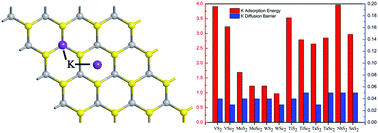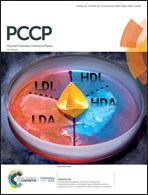Two-dimensional transition metal dichalcogenides as promising anodes for potassium ion batteries from first-principles prediction
Abstract
Two-dimensional (2D) materials are expected to be utilized as electrodes for alkali metal ion batteries due to their exceptional properties, but the larger size of K ions has been supposed to induce structural collapses and low charge–discharge efficiency. In this work, we propose transition metal dichalcogenide (TMD) materials as the anode electrodes for potassium ion batteries (PIBs). K ions can stably be adsorbed on most of the TMD materials with strong adsorption energies, and the structural phase transition from the 2H phase to the 1T phase can further enhance the K adsorption. It is surprising that, the diffusion barriers for K ions on TMD monolayers are low enough (less than 0.05 eV) to allow K ions to freely migrate. Among the TMD materials that we consider here, both VS2 and TiS2 exhibit extraordinary properties with good electronic conductivity, fast K diffusion, optimal open circuit voltage and high theoretical K storage capacity, which are promising anode materials for K ion batteries.



 Please wait while we load your content...
Please wait while we load your content...